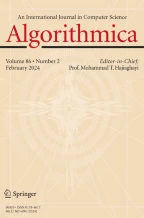Abstract
Efficient data structures are given for the following two query problems: (i) preprocess a setP of simple polygons with a total ofn edges, so that all polygons ofP intersected by a query segment can be reported efficiently, and (ii) preprocess a setS ofn segments, so that the connected components of the arrangement ofS intersected by a query segment can be reported quickly. In these problems we do not want to return the polygons or connected components explicitly (i.e., we do not wish to report the segments defining the polygon, or the segments lying in the connected components). Instead, we assume that the polygons (or connected components) are labeled and we just want to report their labels. We present data structures of sizeO(n 1+ε) that can answer a query in timeO(n 1+ε+k), wherek is the output size. If the edges ofP (or the segments inS) are orthogonal, the query time can be improved toO(logn+k) usingO(n logn) space. We also present data structures that can maintain the connected components as we insert new segments. For arbitrary segments the amortized update and query time areO(n 1/2+ε) andO(n 1/2+ε+k), respectively, and the space used by the data structure isO(n 1+ε. If we allowO(n 4/3+ε space, the amortized update and query time can be improved toO(n 1/3+ε andO(n 1/3+ε+k, respectively. For orthogonal segments the amortized update and query time areO(log2 n) andO(log2 n+klogn), and the space used by the data structure isO (n logn). Some other related results are also mentioned.
Similar content being viewed by others
References
P. K. Agarwal, Partitioning Arrangements of Lines: II. Applications,Discrete Comput. Geom. 5 (1991), 533–573.
P. K. Agarwal, Ray Shooting and Other Applications of Spanning Trees with Low Stabbing Number,SIAM J. Comput. 21 (1992), 540–570.
P. K. Agarwal, M. van Kreveld, and M. Overmars, Intersection Queries in Curved Objects,J. Algorithms 15 (1993), 229–266.
P. K. Agarwal and M. Sharir, Applications of aNew Space Partitioning Technique,Discrete Comp. Geom. 9 (1993), 11–38.
B. Aronov, H. Edelsbrunner, L. Guibas, and M. Sharir, Improved Bounds on the Complexity of Many Faces in Arrangements of Segments,Combinatorica 12 (1992), 261–274.
R. Bar Yehuda and S. Fogel, Good Splitters with Applications to Ray Shooting,Algorithmica 11 (1994), 133–145.
B. Chazelle, M. Sharir, and E. Welzl, Quasi-Optimal Upper Bounds for Simplex Range Searching and New Zone Theorems,Algorithmica 8 (1992), 407–430.
S. W. Cheng and R. Janardan, Algorithms for Ray-Shooting and Intersection Searching,J. Algorithms 13 (1992), 670–692.
T. H. Cormen, C. E. Leiserson, and R. L. Rivest,Introduction to Algorithms, MIT Press, Cambridge, MA, 1990.
M. Dillencourt, H. Samet, and M. Tammiuen, A General Approach to Connected Component Labeling for Arbitrary Image Representation,J. Assoc. Comput. Mach. 39 (1992), 253–280.
D. P. Dobkin and H. Edelsbrunner, Space Searching for Intersecting Objects,J. Algorithms 8 (1987), 348–361.
H. Edelsbrunner,Algorithms in Combinatorial Geometry, Springer-Verlag, Berlin, 1987.
L. Guibas, Personal communication.
L. Guibas, M. Overmars, and M. Sharir, Ray Shooting, Implicit Point Location, and Related Queries in Arrangements of Segments, Techn. Rep. No. 433, New York University, 1989.
J. Gupta, R. Janardan, and M. Smid, Further Results on Generalized Intersection Searching Problems: Counting, Reporting and Dynamization,Proc. 3rd Workshop on Algorithms and Data Structures (1993), Lecture Notes in Computer Science, Vol. 709, Springer-Verlag, Berlin, pp. 361–372.
J. Gupta, R. Janardan, and M. Smid, Efficient Algorithms for Generalized Intersection Searching on Non-Iso-Oriented Objects,Proc. 10th ACM Symposium on Computational Geometry (1994), pp. 369–378.
J. Gupta, R. Janardan, and M. Smid, On Intersection Searching Involving Curved Objects,Proc. 4th Scand. Workshop on Algorithms Theory (1994), Lecture Notes in Computer Science, Vol. 824, Springer-Verlag, Berlin, pp. 183–194.
H. Imai and T. Asano, Finding the Connected Components and a Maximum Clique of an Intersection Graph of Rectangles in the Plane,J. Algorithms 4 (1984), 310–323.
R. Janardan and M. Lopez, Generalized Intersection Searching Problems,Internat. J. Comput. Geom. Appl. 3 (1993), 39–70.
J. Matoušek, Range Searching with Efficient Hierarchical Cuttings,Discrete Comput. Geom. 10 (1993), 157–182.
K. Mehlhorn,Data Structures and Algorithms 3: Multi-Dimensional Searching and Computational Geometry, Springer-Verlag, Berlin, 1984.
J. Nievergelt and P. Widmayer, Guard Files: Stabbing and Intersection Queries on Fat Spatial Objects,Comput. J. 36 (1993), 107–116.
M. H. Overmars,The Design of Dynamic Data Structures, Lecture Notes in Computer Science, Vol. 156, Springer-Verlag, Berlin, 1983.
M. H. Overmars, H. Schipper, and M. Sharir, Storing Line Segments in Partition Trees, BIT 30 (1990), 385–403.
F. P. Preparata, A Real Time Algorithm for Convex Hull,Comm. ACM 22 (1979), 402–405.
F. P. Preparata and M. I. Shamos,Computational Geometry—an Introduction, Springer-Verlag, New York, 1985.
N. Sarnak and R. Tarjan, Planar Point Location Using Persistent Search Trees,Comm. ACM 29 (1986), 609–679.
H. W. Schölten and M. H. Overmars, General Methods for Adding Range Restrictions to Decomposable Searching Problems,J. Symbolic Comput. 7 (1989), 1–10.
M. Sharir and P. Agarwal,Davenport-Schinzel Sequences and Their Geometric Applications, Cambridge University Press, New York, 1995.
R. E. Tarjan, Amortized Time Complexity,SIAM J. Discrete Math. 6 (1985), 306–318.
D. E. Willard and G. S. Lueker, Adding Range Restriction Capability to Dynamic Data Structures,J. Assoc. Comput. Mach. 32 (1985), 597–617.
Author information
Authors and Affiliations
Additional information
Communicated by B. Chazelle.
Part of this work was done while the second author was visiting the first author on a grant by the Dutch Organization for Scientific Research (N.W.O.). The research of the second author was also supported by the ESPRIT Basic Research Action No. 3075 (project ALCOM). The research of the first author was supported by National Science Foundation Grant CCR-91-06514.
Rights and permissions
About this article
Cite this article
Agarwal, P.K., van Kreveld, M. Connected component and simple polygon intersection searching. Algorithmica 15, 626–660 (1996). https://doi.org/10.1007/BF01940884
Received:
Revised:
Issue Date:
DOI: https://doi.org/10.1007/BF01940884
